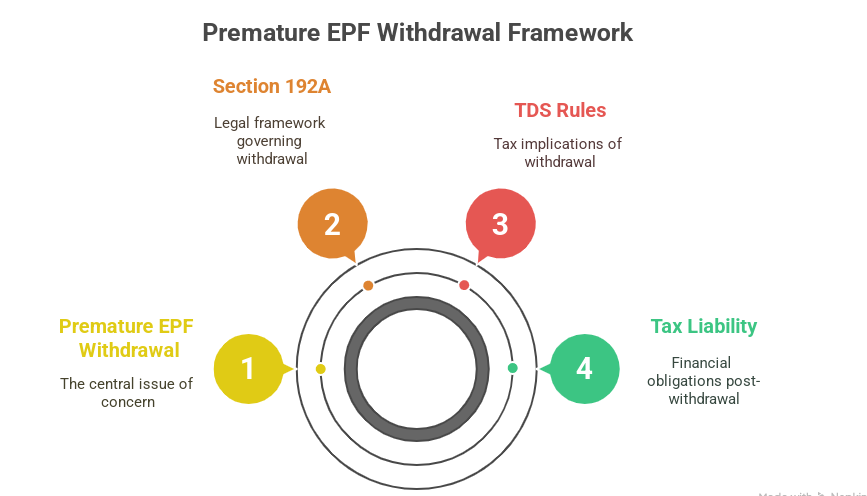Premature withdrawal from the Employees’ Provident Fund (EPF) is a topic of considerable importance for both employees and employers, especially in the context of tax implications and legal compliance. This article breaks down the key aspects under Section 192A of the Income Tax Act, Rule 9 of Part A of the Fourth Schedule, and related provisions.
Premature EPF Withdrawal – Section 192A, TDS Rules, and Tax Liability Explained

1. What is Recognised Provident Fund ( RPF ) ?
Under the Employees’ Provident Fund and Miscellaneous Provisions Act, 1952 (EPF & MP Act, 1952), specific employers are mandated to enroll in the Employees’ Provident Fund Scheme, 1952 (EPFS). However, they are also allowed to set up and manage their own private provident fund (PF) schemes, provided they meet certain regulatory conditions.
Provident funds established under EPFS or exempted under Section 17 of the EPF & MP Act and recognized under the Income-tax Act, 1961, are referred to as Recognized Provident Funds (RPFs).
2. When Withdrawal From EPF is Tax Free ?
According to Rule 8 of Part A of the Fourth Schedule to the Income-tax Act, 1961, the accumulated balance withdrawn by an employee from a Recognized Provident Fund is tax-exempt, provided certain conditions are met.
To promote long-term savings and discourage premature withdrawals, tax exemption is not available in the following cases:
- If the employee withdraws the EPF balance before completing five continuous years of service.
- If the balance is not transferred to a new employer’s PF account.
- Exceptions include termination due to ill health, business discontinuation, or other unavoidable causes.
3.How Premature Withdrawal from EPF is Taxed ?
In cases where Rule 8 is not applicable, Rule 9 prescribes the method for computing tax on premature withdrawals. The main provisions include:
- The tax liability is recalculated for each year of contribution by treating contributions as made to an unrecognized provident fund.
- Trustees of private provident fund schemes, typically part of the employer group, can access employee tax details and ensure correct tax calculation.
- However, trustees of EPFS may face difficulty obtaining year-wise employee tax information, which can complicate accurate tax computation under Rule 9.
4. Who deducts TDS on Withdrawal From EPF ?
To ensure tax compliance, Rule 10 of Part A of the Fourth Schedule requires the trustees of RPFs to deduct tax at source (TDS) as computed under Rule 9 at the time of payment of the withdrawn amount.
5. What is the Rate of TDS on premature Withdrawal From EPF ?
Section 192A of the Income-tax Act governs the tax deduction at source on premature EPF withdrawals. Key points include:
- A TDS rate of 10% is applicable when the withdrawn amount is taxable due to non-fulfillment of Rule 8 conditions.
- This deduction is mandatory for EPFS trustees or any authorized persons making the payment.
6. When is TDS Deducted on EPF Withdrawal ?
TDS must be deducted at the time of payment of the accumulated balance to the employee. Any delay in this can result in penalties and interest under the Income-tax Act.
7. What is the Threshold for TDS Exemption under Section 192A ?
TDS under Section 192A is not applicable if the total withdrawal amount is less than ₹50,000. This provides relief to employees making smaller withdrawals.
How to Avoid TDS on EPF Withdrawal?
* Avoid withdrawing EPF before 5 years of service
* Choose to transfer your PF balance when switching jobs
* Ensure total withdrawal is below ₹50,000
Conclusion
Premature withdrawals from the Employees’ Provident Fund can attract tax liabilities if certain conditions aren’t met. Both employees and trustees must understand the implications of Section 192A, and Rules 8, 9, and 10 of Part A of the Fourth Schedule to ensure proper compliance and avoid penalties. Encouraging the transfer of PF balance during job switches and avoiding premature withdrawals can help preserve long-term savings and offer full tax benefits. Taxpayers also need to know the difference between RPF and PF for tax implications purposes.
